Caleb Gattegno
1911-1988
Caleb Gattegno was the teacher every student dreams of: he didn’t require his students to memorize, he didn’t speak loudly – at times he didn’t say a word – and his students learned at an accelerated rate because they were engaged and realizing their potential. In a world where memorization, recitation, and standardized tests remain the norm, Gattegno was well ahead of his time.
He was the author of philosophical works, books on psychology, educational materials, fiction and treatises on a wide variety of subjects, including the brain, awareness, energy, death, health, love, and economics. His exploration of those topics convinced him that, while one is essentially the same person all one’s life, healthy humans constantly learn and evolve. For Gattegno, human learning adds to and enhances our existing abilities, to meet the demands of future challenges. He replaced theories that rely exclusively on some combination of nature and nurture to explain human learning and behavior with one that centralizes the influence of the uniquely human capacity for awareness and the awareness of awareness, which emanates from consciousness, which he understood as a quantum of energy present in the human organism from the moment of conception until the moment of death.
A self-taught scholar in many fields, he held a doctorate in mathematics, a doctorate in psychology, a master of arts in education, and a bachelor of science in physics and chemistry. He maintained a scientific view of education and professed to have devised a solution to illiteracy, which he applied to more than twenty languages, both alphabetic and otherwise. He introduced the dramatic notions that time and algebra should play crucial roles in the process of learning to read and write.
Gattegno had not considered the problem of reading until he went to Ethiopia on a United Nations literacy mission in 1957. The city of Addis Ababa was shut down for Christmas when he arrived, giving him time to himself. During that 48 hour period, he learned how to read the local language. When he discovered that it is supposed to take 18 months to teach Amarinya, he felt compelled to test his method on others. Gattegno had illiterate ministry employees in their 50s and 60s reading newspapers within six hours.
His broad set of insights extended to educational solutions in foreign language instruction in dozens of tongues, mathematics at all levels, and supporting the learning of persons with disabilities, particularly deafness. Having founded what he described as the Science of Education, he created materials, techniques and activities that provide teachers the tools to practice his “subordination of teaching to learning,” where the focus in all subjects, he insisted, should always be placed on learning, not on teaching.
He outlined learning to involve the following stages:
Awareness – encountering and noticing something unknown
Exploration – experimenting through trial and error, and drawing conclusions and criteria from one’s mistakes
Transition – practicing, which leads to speed and accuracy
Mastery – taking newly formulated know-hows, insights, understanding and knowledge and applying them to further learning
He realized that in every situation and in all circumstances, humans learn only what they essentially teach themselves. Given this realization, that regardless of the manner of instruction, it is always up to the individual to attend to and make sense of what is to be learned, he knew the correct role of the teacher is not to inform students. Rather it is a teacher’s responsibility to create situations and challenges that invite students to use their innate learning powers to master academic subjects with the same verve and alacrity we all, as babies, display in our early learning. Essentially, if we teach ourselves everything we know, it follows that teachers should practice a pedagogy that directly supports the process.
His contribution to the improvement of education supersedes other nominally progressive or constructivist approaches, as he advocated a “learning centered” perspective, where the teacher is seen less as a guide or facilitator and, instead, as a sensitive, finely tuned responder to the movements of learners in real time – to what they say and do and, mostly by astute (and cautious) inference, to what they think and feel. As such, the teacher’s responsibility is to observe acutely what learners say and do, from moment-to-moment, and to intervene minimally in response, primarily through a refined question or adjustment to the presented challenge. In that manner, teaching is flexible and creative, molding constantly to learning. With such teaching, learners’ mistakes are recognized and welcome as guidance to the instructor. Eschewing practices such as telling the students answers or, somewhat more subtly, controlling their responses with leading questions, teachers who subordinate their teaching to their students’ learning attend to the process of learning and leave the focus on outcomes where they belong, with the learner.
Among his revolutionary ideas is the notion that mastering subject matter – while of course important in and of itself – can be the vehicle to arrive at something even more valuable, that is, knowing oneself as an extremely competent learner. Thus he saw academic content, which to most people in at least some subjects feels daunting and even deflating, as an opportunity, always and for everyone, to recapture the brilliance with which they entered into and conquered intellectual and affective challenges in their earliest years. Among those, Gattegno considered teaching yourself your mother tongue to be most noteworthy and indicative of every person’s capacity to manage learning challenges that equal or exceed in complexity and nuances involved in mastering academics.
Why then do so many of us find some or even most of school boring or sapping us of confidence in one or more basic subjects? Why are subjects like nuclear physics, calculus and molecular biology seemingly beyond the abilities of but a select few? For Gattegno, the answer was deceptively simple and direct: it is due to commonly poor teaching of those subjects and those that necessarily precede them, teaching that relies mostly on memorizing, listening to and trying to understand and remember a teacher’s or a textbook’s words and regurgitating them, with a dependence on encouragement, praise, grades and occasional entertainment as the primary means to keep learners focused.
His insights led Gattegno to develop teaching tools which ensure that students at all times have criteria – an inner certainty about what they are doing and why – and which also appeal to the naturally stimulating and energizing human attributes of imagination, creativity, insight and intuition. Under the trade names of Words in Color for literacy, The Silent Way for learning a foreign language, and Visible and Tangible Mathematics, he crafted those sets of tools to evoke inherent learning powers – including, for example, abstraction, stressing and ignoring, recognition, retention, imaging, evocation – while at the same time keeping learners consciously in touch with those powers. The concepts of ensuring criteria, seeing the classroom as a laboratory to investigate and refine instruction, and maintaining joy in discovering the unknown, are among the bases of Gattegno’s work.
Gattegno travelled the world many times, conducting seminars on his approach with thousands of teachers. He himself had mastered the basics of more than 40 languages and achieved fluency in a least a half dozen. He published over 120 books during his career, and too many articles, essays and newsletters to easily count. He died in Paris in 1988, two weeks after presenting a seminar titled Le Mystère de la Communication, near Grenoble, France. Dr. Gattegno is survived by a few children and his wife Shakti Gattegno, perhaps his most devoted student, ardent supporter and living expert in his pedagogy.
Bibliography
Books, Newsletters, Collaborations, Software, Film, Filmstrips, Video and Posthumous Publications.
1937-1949
(1937) Les cas essentiellement géodésiques des équations de Hamilton-Jacobi intégrables par séparation des variables, unpublished D Phil thesis, Basle University
(1941) Contribution à l'étude psychologique du Trac.' Bulletin de l'Institut d'Egypte
(1943) ‘Les problèmes de l'éducation de l'après guerre’ in Le Progrès Egyptien, novembre
(1944) ‘Les enfants et nous’ Causerie pédagogique in Les Lettres françaises, Le Caire.
(1944) ‘Six contes pour enfants’, Les Lettres françaises, Le Caire.
(1945) ‘Analyse générale et topologie de l'espace des connaissances’ in Bulletin de l'Institut d'Egypte, N° 28.
(1945) 'Etude sur le Jeu', Bulletin de l'Institut d'Egypte, 27
(1946) 'Studies in the structure of the mind', Mind, vol LV, no 219
(1947) 'Mathematics and the Child' in The Mathematical Gazette Vol. 31, N°. 296, octobre. Grande Bretagne. Repris dans For the Teaching of Mathematics Vol.1, 1963.
(1948) ‘Psychologie du Dessin Enfantin’ in Enfance N°. 5, novembre-decembre. France.
(1948) ‘The Use of Mistakes in the Teaching of Mathematics’ in The Mathematical Gazette, Vol. 32, N° inconnu. Grande Bretagne.
(1948) The mathematical definition of education, unpublished MA thesis, London University
(1949) ‘Substitutes and Examples’ in The Mathematical Gazette Vol.33, N°. 304, mai. Grande Bretagne. Repris dans For the Teaching of Mathematics Vol.1, 1963.
(1949) with A M Ostrowski, Représentation conforme à la frontière ; domaines généraux, 2 vols, Gauthiers-Villars, Paris.
(1949) Polynômes de base, par J. M. Whittaker. Autres détails inconnus.
(1949) 'International N.E.F. Conference in Brussels July 10-17, 1949', The New Era, vol 30, no 9
(1949) 'Further experiments in international education', The New Era, vol 31, no 10
(1949) ‘Pour une éducation de la conscience mondiale’ in Revue spiritualité, N° 60, 61, 62, Novembre – Février 1949-1950
1950-1959
(1951) ‘Adolescent Thought and its bearing on Mathematics Learning’ in Revue Belge de Psychologie et de Pédagogie, Vol. 13, N°. 55-56. Belgique. Repris dans For the Teaching of Mathematics Vol. 2, 1963.
(1951) ‘Remarks on Mental Structures’ in Enfance N°. 3. mai-juin. France. Repris dans For the Teaching of Mathematics Vol. 2, 1963.
Obituary
Caleb Gattegno, 76, a Proponent Of Novel Learning Theories, Dies
By Glenn Fowler
Published: August 4, 1988 in The New York Times
Caleb Gattegno, an educator who developed novel and sometimes controversial theories of the learning process, died last Thursday after surgery for cancer at a clinic in Paris. He was 76 years old. Dr. Gattegno, who lived and worked in Manhattan, where he was the founder and president of Educational Solutions Inc., … The main thrust of Dr. Gattegno's research and teaching, embodied in more than 50 books and countless other writings, is that learning, particularly of language and mathematics, is hindered rather than helped by pedagogical practices.
His Own Account
Caleb Gattegno wrote his own obituary before he died. Here is his account:
My death is placed here last among the achievements of this life of mine, though it could be given an earlier spot.
By shifting from death to my death, in the effort of understanding that phenomenon which looms so large in pre-human consciousness, I gave myself both an epistemological edge
ASE - Association for the science of education
The Association for the Science of Education is honored to co-publish this Memoir with Educational Solutions Inc., the company originally founded by Dr. Caleb Gattegno to make his compelling vision of human learning available to teachers and students.
The Association’s purpose is to help realize that vision of human and humane learning. It was in the early 1970s at the Educational Solutions offices in New York City that many of the members of our Association first encountered Dr. Gattegno’s work and, indeed, the man himself. The contributions to this Memoir by our members and non-members alike recall “Dr. G” in the context of East 12th Street, Fifth Avenue, or University Place, each one a memorable space in its own right. Participants hail from Europe, Africa, Asia, Australia, North America and South America, attesting to the world-wide reach and appeal of Dr. Gattegno’s work.
We are hoping that the publication of this Memoir will increase the cadre of educators all over the world who share the certainty that the future of education is bright with promise. They will move forward with the confidence and creativity that find surety in the profound learning powers that are our birthright.
Bill Bernhardt
President, The Association for the Science of Education [ASE]
The Gattegno Effect
100 Voices on One of History’s Greatest Educators.
Press
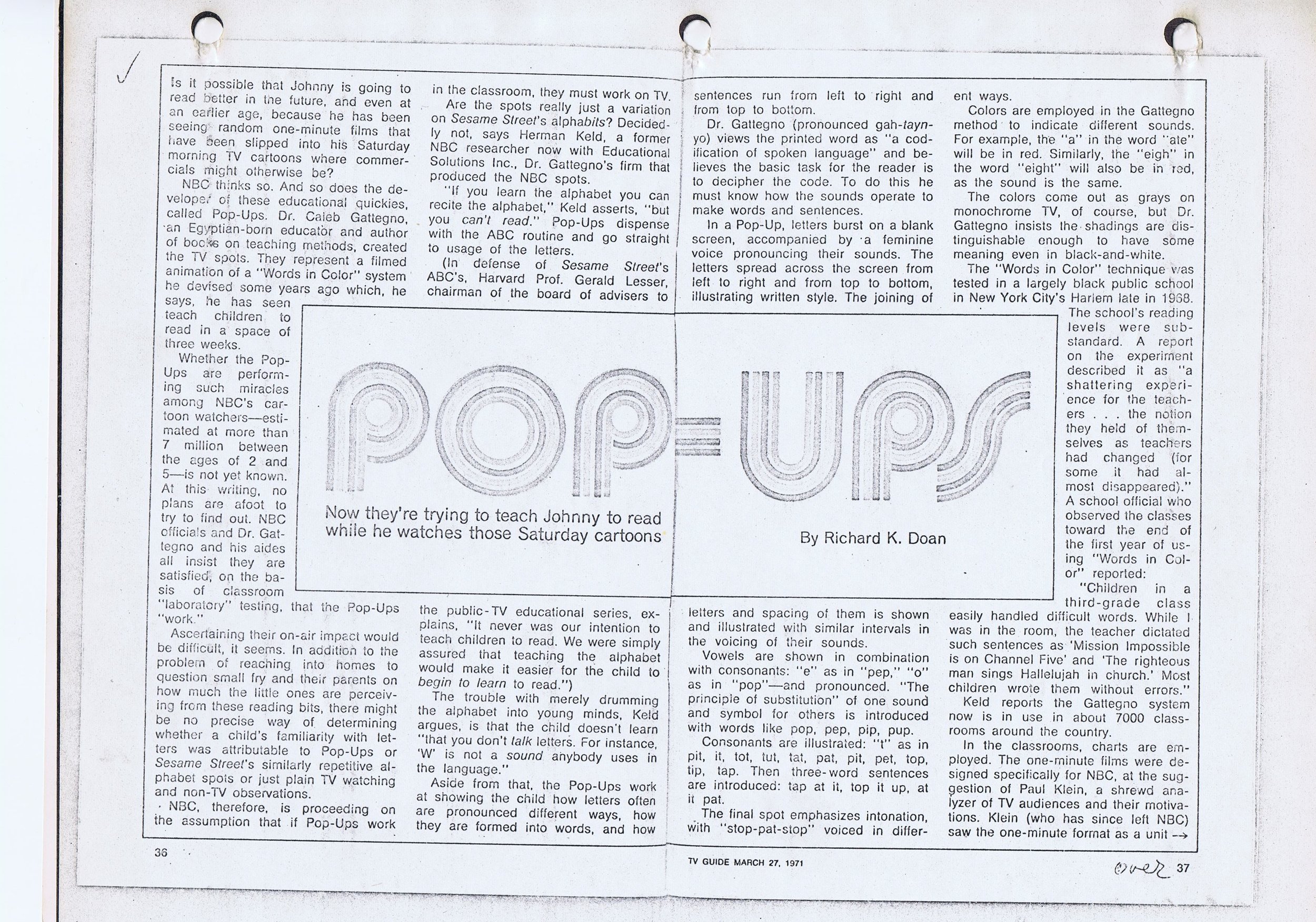
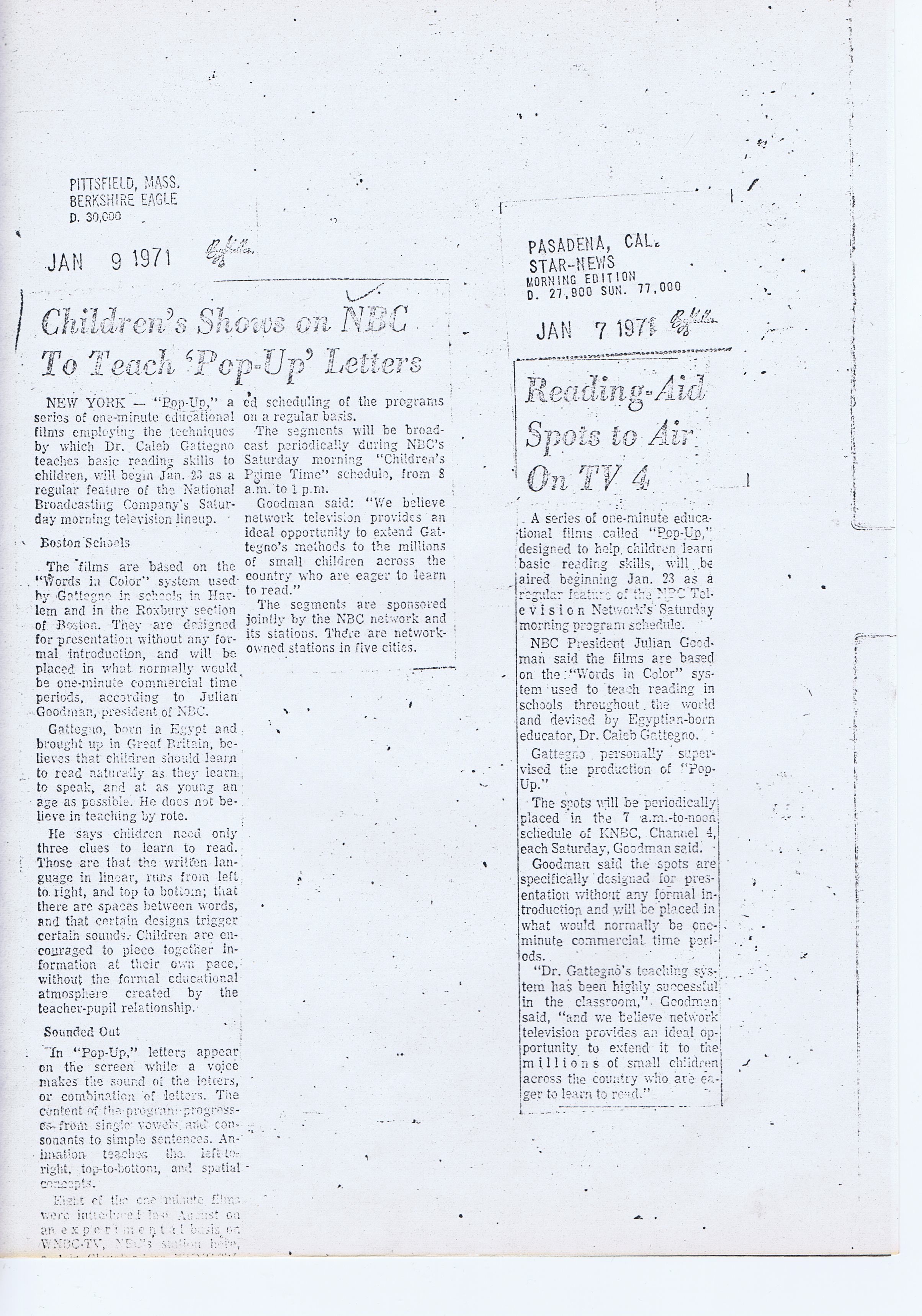
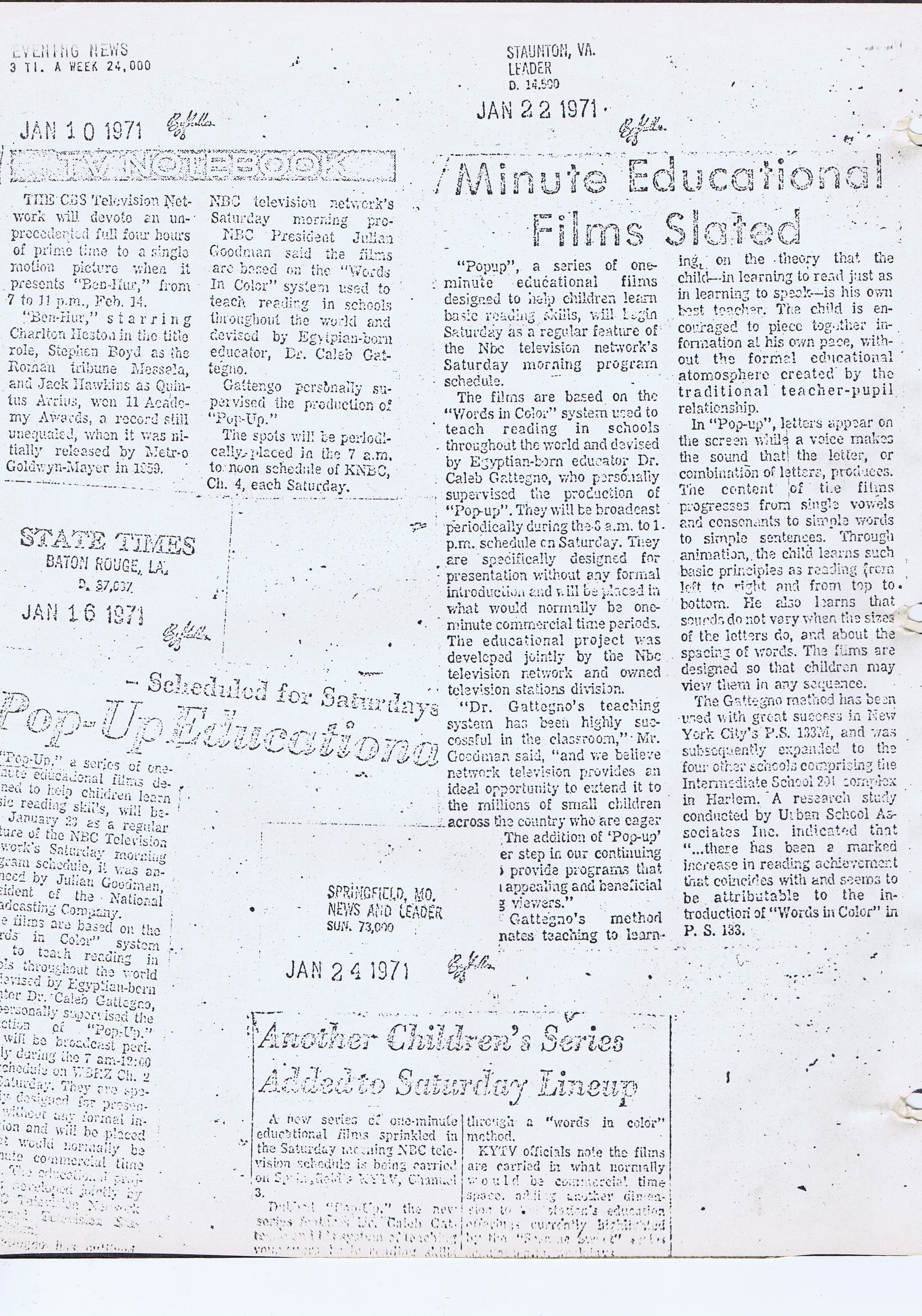
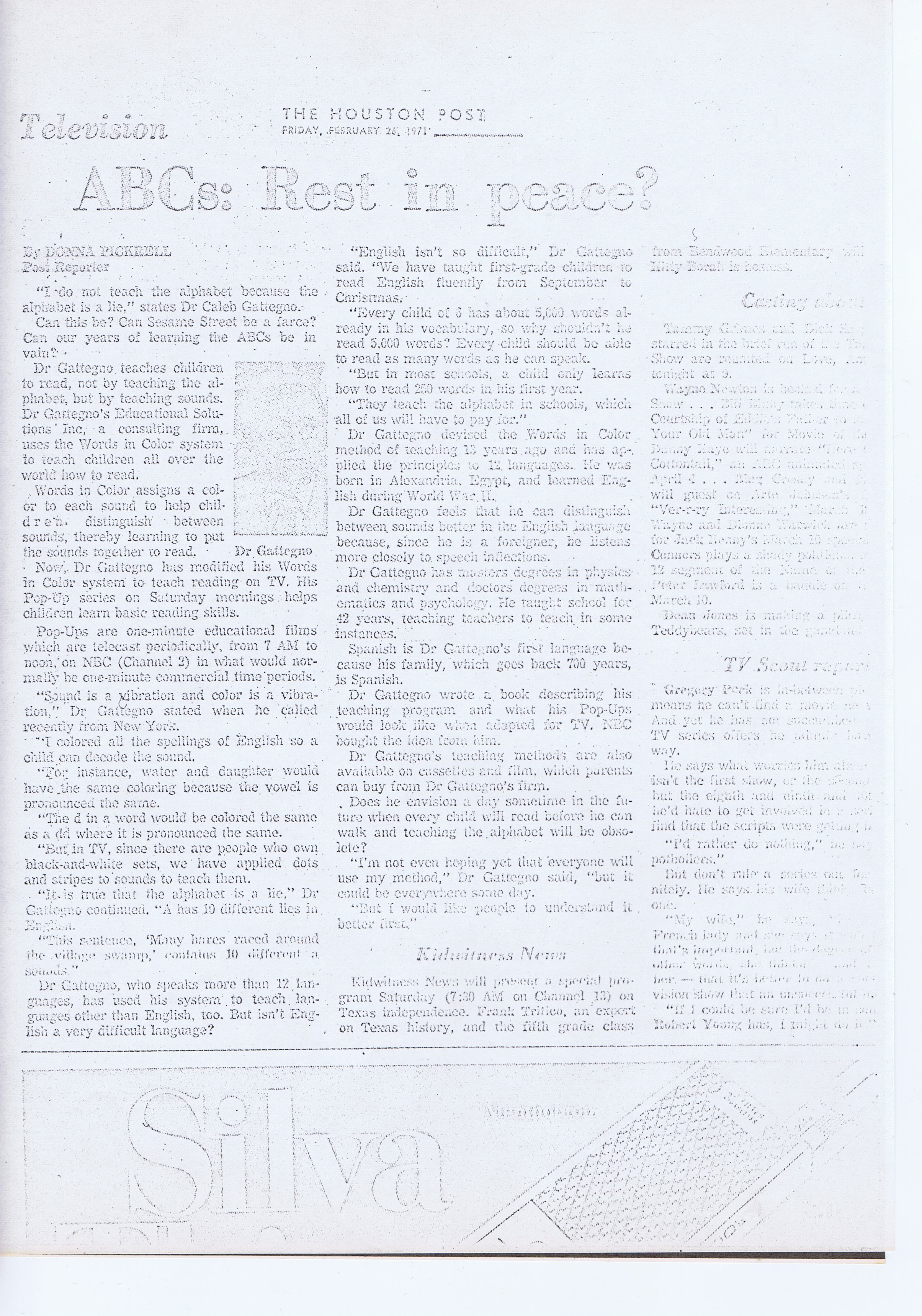
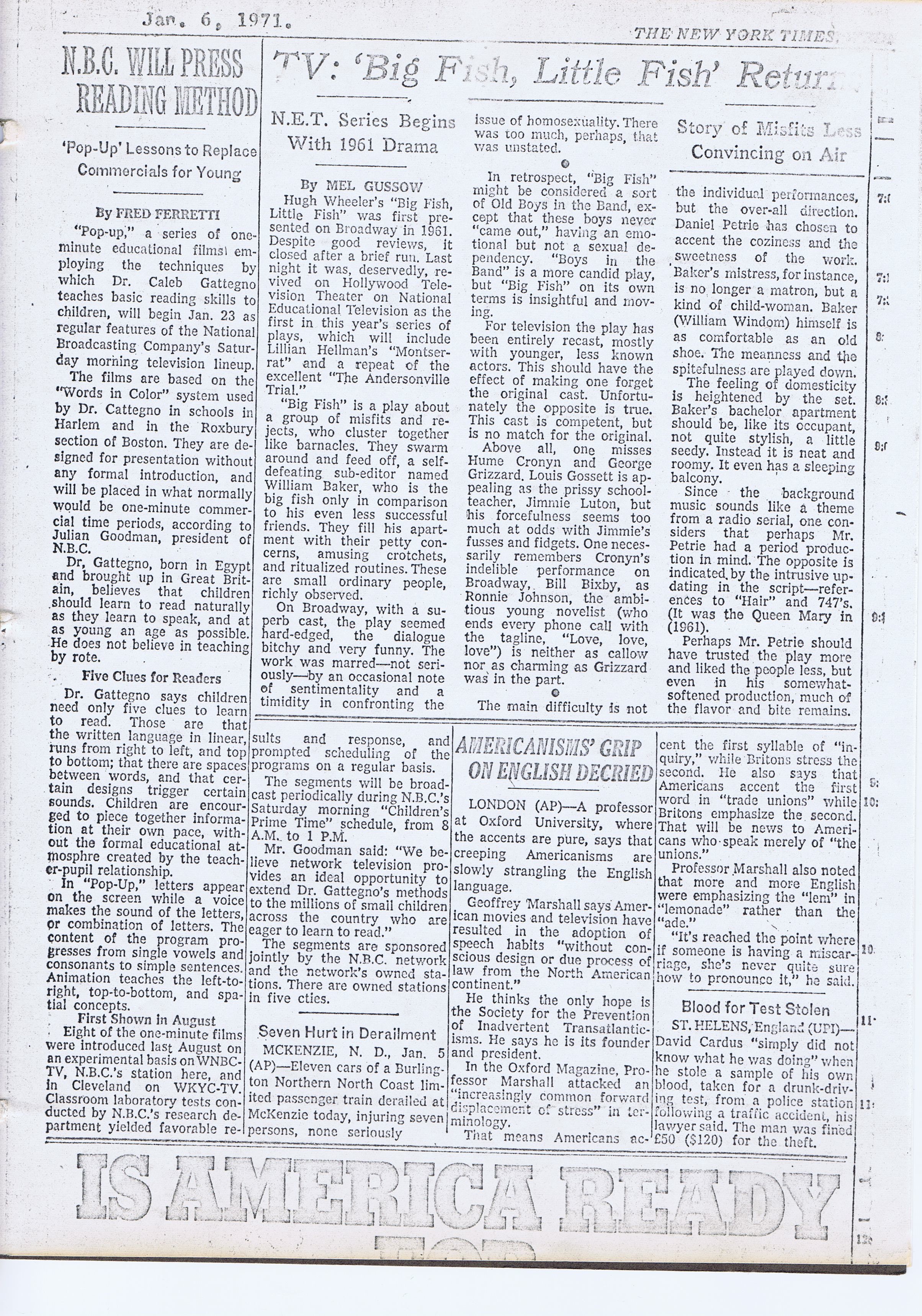



Briton to Expound New Learning Approach on TV
September 28, 1970
by McClandish Philips
If Dr. Gattegno’s words boil down to the assertion that children are taught to read in the wrong way, at the wrong time, in the wrong place. Nearly as much can be said of the teaching of mathematics, of biology, of music … he does not therefore challenge American education on some point of methodology; he challenges it in the way Copernicus challenged the belief that the sun revolved around the earth – that is, at the heart of it most fundamental and honored assumptions. … it mandates a new relationship between the teacher and the learner … ‘A child who is released from the domination of teaching procedures, and allowed to learn, will acquire a great deal in a short time’ Dr. Gattegno asserts … He is death on teaching by drill and rote. Such classic methods concentrate on imparting knowledge, while Dr. Gattegno believes that what should be imparted is a way of knowing.
‘Knowing is far more important than knowledge. Knowledge becomes obsolete; knowing does not’.”
Harvard Educational Review - May 1970
The Harvard Educational Review
HARVARD EDUCATIONAL REVIEW, VOLUME FORTY, NUMBER TWO
A SPECIAL ISSUE : Illiteracy in America
The Problem of Reading is Solved [Position Paper]
CALEB GATTENGNO
Schools for the Future Foundation, Inc.
Dr. Caleb Gattegno holds that reading is a relatively simple process of matching the sound system of a language with its written system. Children can be easily taught to do this, helped by color-coded instructional material, since they internalized the algebraic and temporal structure of their language when they learned to talk.
As a scientist I came to the problem of reading as I did to problems in the field of mathematics or physics, by first defining them and then attempting to find solutions.
There is indeed a problem of reading and it can be formulated as follows: “how to provide awareness that a system of signs isomorphic to the system of sounds of one’s language exists and can play a certain number of the roles of the system already owned?”















